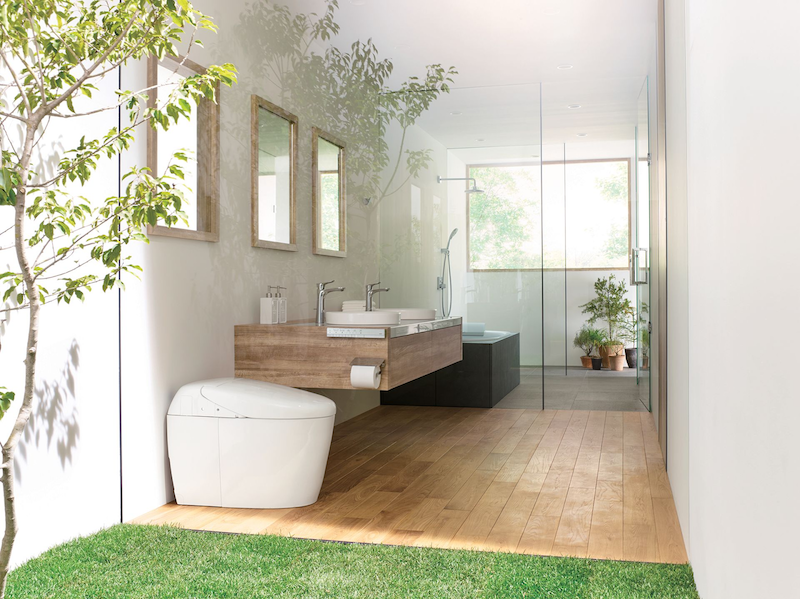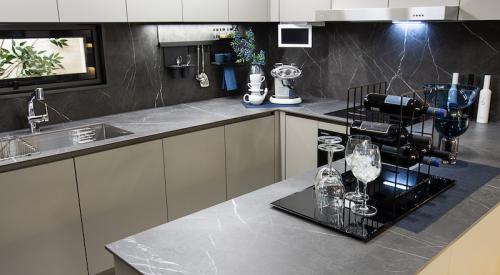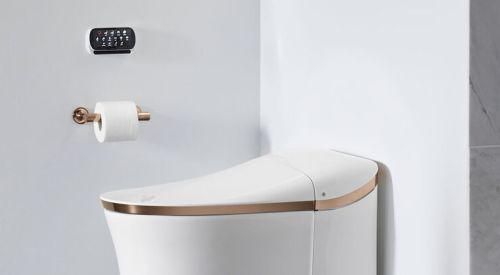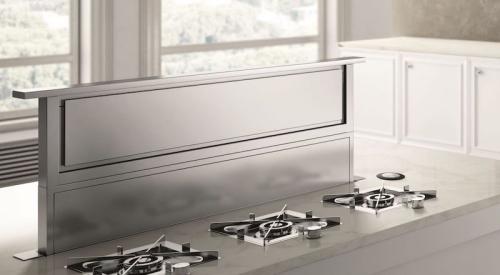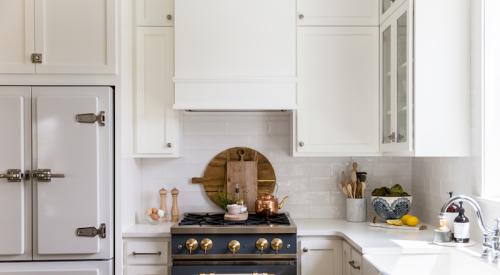If you’ve been washing your hands way more in the past month than you have in a year, you’re not alone. COVID-19 is disrupting industries and reshaping many Americans' relationship to hygiene, which could accelerate the adoption of touch-free technology in the future.
The spread of coronavirus is disrupting American life in ways the country hasn’t seen in a generation. Some states, such as California and Indiana, have issued shelter-in-place orders. With businesses shutting down and patients fighting for their lives, home design is understandably not on the top of people’s minds. But when the dust clears, the lessons of limiting transmission and maintaining hygiene may linger in ways that can extend to home design.
New trends in residential construction do not happen quickly. But changing trends in other industries mark a shift towards limiting transmissions of germs and viruses: The real estate industry evolved almost overnight in response to the coronavirus.
[ Related: 7 DESIGN IDEAS TO STEAL FROM THE 2020 NEW AMERICAN HOME ]
In order to protect realtors, homebuyers, and sellers, Redfin and other companies beefed up their digital buying tools and turned toward virtual showings. In just weeks, customer demand on Redfin for virtual showing rose nearly 500 percent. It is still up in the air if this trend will continue to grow as fast as it is currently, but Redfin CEO Glenn Kelman says that it will leave its mark on the industry.
“The future of real estate has come earlier than any of us could have anticipated,” Kelman says on the Redfin blog. “The way things are during the pandemic won’t last forever, but at the end of all this, things won’t go back to the way they were either. We hope we’re well prepared.”
How COVID-19 spreads
The CDC says “it may be possible that a person can get COVID-19 by touching a surface or object that has the virus on it and then touching their own mouth, nose, or possibly their eyes.”
According to new research studies, COVID-19 can live on cardboard surfaces for up to a day and a whooping 72 hours on metal and plastic. Though the virus’ viability decreases substantially as time goes on, experts say people still should continue to clean and disinfect high-touch surfaces such as sinks, faucets and door handles, light switches, and toilets.
[ Related: GROHE ADDS NEW SMART KITCHEN UNIT TO THE LADYLUX FAUCET COLLECTION ]
It wouldn’t be logical to go out and change every toilet to an automatic flush as a first response to the coronavirus: Transmission is primarily through person-to-person spread, the Center for Disease Control (CDC) says. But COVID-19’s ability to live on surfaces can spark conversation on how to limit touchpoints in a home so we can create healthier home environments, both for daily life and for future pandemics.
Touch-free technology: The past and the future
Even before COVID-19, manufacturers and city planners have touted smart, touch-free products as ways to create a healthier environment. “Hands-free faucets have been around since the 1970s, when they were sold under the name 'proximity faucets’ and were marketed to offer several advantages, including greater convenience, less maintenance, and improved hygiene,” Sloan says in an educational document on touchless faucets for Hanelywood University. Since then, commercial spaces have pounced on touch-free technology, which does not come as a surprise to anyone who has struggled to get the right amount of paper towel from an automatic dispenser. But the residential sector is also wading into the touch-free waters.
Lately, companies have integrated touchless technology into their smart home offerings. At KBIS 2020, Kohler debuted both touchless faucets and toilets. For the new touch-free toilet technology, Kohler says that “users can flush without spreading bacteria by simply placing their hand in front of the lever.”
Moen’s new faucet, U by Moen, will work hands-free no matter what position the handle is in via voice control. “To activate the U by Moen Smart Faucet, users simply ask Amazon Alexa or the Google Assistant to turn the water on or off, as well as dispense precise measurements and temperatures,” Moen says. “Once they have created personalized presets in the Moen app, homeowners only need to state the name of the preset within the command.”
[ Related: 8 WINNERS OF THE BEST OF KBIS AWARDS 2020 REVEALED ]
But touchless technology does not stop at the kitchen and bath: lighting systems, locks, and even garage door openers have gone hands-free, using apps and smart home assistants to operate instead of manual switches.
We’ve rounded up 7 ways designers can make a home as hands-free as possible:
Take command with a voice-activated faucet.
Handwashing is king when it comes to maintaining a healthy home. But the sink can actually harbor more bacteria than toilet seats. From faucets that activate with the touch of the back of a hand to ones that are voice-controlled, modern-day models have a spectrum of offerings that limit the physical contact homeowners have with their sinks.
Using the touchless technology, users can also activate Kohler’s Sensate Touchless Faucet with a wave of their hand, and the faucet will respond in 20 milliseconds. They can also control the faucet with voice commands such as “Turn my faucet on.”
The One-Handle High Arc MotionSense Pulldown Kitchen Faucet in Arbor Chrome uses motion-sensing technology on both the top and front of the faucet to create a touch-free experience.
Flush hands-free.
Looking to make a clean getaway after a trip to the bathroom? Automatic flush toilets help homeowners avoid touching toilet handles before washing their hands but after-- you know. Smart toilets nowadays often have automatic flush, but some standard toilets can come equipped with that feature as well. For more hands-free capabilities, some models even have automatic open-and-close lids.
Niara, the tankless smart toilet from Dyconn includes both hands-free radar sensors and a manual kick button to open, close, and flush the unit. For increased sanitation, Dyconn designed the stainless steel bidet to be self-cleaning.
With sensor-flushing capabilities and an automatic open-close function, the Neorest H Dual Flush Toilet is hands-free.
[Related: 9 TOP SMART HOME PICKS WE SAW IN 2019]
Secure the home.
Contact-free deliveries are one of the innovations coming out of businesses adapting to the new rules guiding daily life during the coronavirus pandemic. With smart security systems and doorbells, homeowners can keep an eye on deliveries without interacting with the person at the door. Additionally, they work well for avoiding contact with solicitors once social distancing subsides.
For those who want a security camera that does double duty, the Wire-free Floodlight Camera by Arlo illuminates the front of a home while also allowing capturing live full-color video. The two-way audio allows users to speak to and hear visitors. An updated version, Arlo Pro 3, will launch soon.
Lights on, lights off.
Automated lights are not just good for cutting down on high-touch zones in the home, but also for the times when you’ve just finished a good book in bed and don’t want to get out of the covers. Lights have come a long way since the “Clap on, clap off” days (though many still have that jingle floating around our heads). Now, lighting systems can be voice activated via smart home hubs or even Bluetooth-integrated so homeowners can control them with apps or use them to play their favorite tunes.
The Brilliant Lighting System gives homeowners the ability to control lights remotely via the app, through motion sensors, and voice-commands.
With the Juno AI Smart Downlight, homeowners can not only control the lights with their voice, but they can use the downlight as a smart hub.
When one door closes, lock it—automatically from anywhere.
Smart locks give homeowners the ability to remotely lock properties from a mobile app. In situations when local governments issue “shelter-in-place” orders, this means that those with second properties will be able to keep tabs on their other homes while remaining safe at their primary residences. Homeowners can also give virtual keys to trusted contacts so the contact can check on the property, all without risking transmission of diseases.
The TL-111 PRO Keyless Smart Door Lock allows users to remotely monitor and lock the door, give eKeys to trusted contacts, and activate “passive mode” which keeps the door unlocked for a set period of time.
Turn up the heat with smart thermostats.
Set it and forget it with smart thermostats. Though this may be a less frequent touchpoint--assuming you’re not in a temperature battle with a spouse or roommate--an intelligent system self-monitors the environment. It will raise or lower the temperature and humidity to a homeowner’s desired ranges without any buttons pressed. Users can also often monitor and remotely control the thermostat via an app.
Ecobee’s Smart Thermostat automatically senses the environment and can learn a homeowner’s routine. Users can also talk to the thermometer to control the temperature, make a call, send a message, or connect through other Alexa-enabled devices.
With the One+ smart thermostat, homeowners can set the smart thermostat manually, or they can use voice commands and apps for touch-free control.
“Open sesame” the garage opener.
We’ve said it before and we’ll say it again: Garages are ripe for design. As one of the gates to the outside world, minimizing contact can cut down on carrying outside germs in before you can get to the sink. Now, smart openers can be activated via a smartphone app as well as keep an eye on what’s going on inside the garage--and out.
The Liftmaster 85503 model includes a wide-angle, high-definition camera and can be remotely controlled via a mobile app.
[Related: 5 DESIGN, PRODUCT RESOLUTIONS YOU SHOULD MAKE FOR 2020 AND BEYOND]
